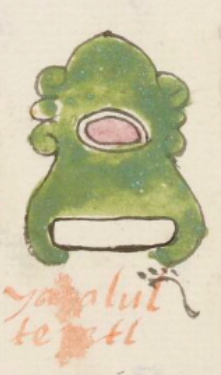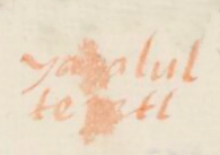Yahualoltepec (TR27r)
This compound glyph for the place name Yahualoltepec shows two main elements. One is a bird's eye view of something that "goes around" (yahualolli). It has a white rim and a pink or red center. The other element is a frontal view of a mottled, green, bell-shaped hill or mountain (tepetl) or, if it serves as a semantic indicator for a locative, -tepec, "on the hill"]. The hill has curling, rocky outcroppings on its slopes and a horizontal white bar or band across the base. The effect of the place name could be something like "What Surrounds the Hill."
Stephanie Wood
Yahualolli is a noun derived from the verb yahualoa, to go around, go on procession, or to surround something. Perhaps in this landscape it refers to something that surrounds the hill, but it appears to be a round, flat object. There is a round object that has a practical use with things that have uneven bottoms, helping to stabilize them, such as a ceramic jug or a log drum (see below).
Stephanie Wood
yaualul
tepetl
Yahualoltepetl (or better, Yahualoltepec)
Stephanie Wood
ca. 1550–1563
nombres de lugares

yahualol(li), something round, https://nahuatl.wired-humanities.org/content/yahualolli
tepe(tl), hill-mountain, https://nahuatl.wired-humanities.org/content/tepetl
En el Cerro Redondo
Stephanie Wood
Telleriano-Remensis Codex, folio 27 recto, MS Mexicain 385, Gallica digital collection, https://gallica.bnf.fr/ark:/12148/btv1b8458267s/f79.item.zoom
The non-commercial reuse of images from the Bibliothèque nationale de France is free as long as the user is in compliance with the legislation in force and provides the citation: “Source gallica.bnf.fr / Bibliothèque nationale de France” or “Source gallica.bnf.fr / BnF.”


